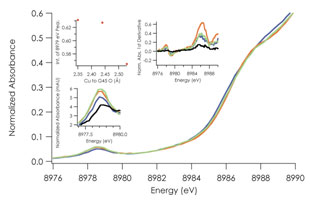Nature adapts copper ions to a multitude of tasks, yet in doing so forces the metal into only a few different electronic structures [1]. Mononuclear copper sites observed in native proteins either adopt the type 1 (T1) or type 2 (T2) electronic structure. T1 sites exhibit intense charge-transfer absorption giving rise to their alternate title, blue copper sites, due to highly covalent coordination by a thiol ligand donated by a cysteine sidechain in their host proteins. This interaction has consequences for the spectroscopic features of the protein, but more importantly gives rise to dramatic enhancement of electron transfer activity. T2 sites on the other hand resemble more closely aqueous copper(II) ions, and are found in catalytic domains rather than electron transfer sites.
While investigating the factors that tune reduction potentials in the T2 C112D variant ofPseudomonas aeruginosa azurin [2], Kyle M. Lancaster, under the guidance of Harry B. Gray and John H. Richards at the California Institute of Technology, discovered a copper(II) coordination mode that did not easily fit either of the two classifications for a mononuclear copper(II) site. The C112D/M121L azurin variant displayed one of the fingerprinting features of T1 copper: namely, a narrow axial hyperfine (A||) in its EPR spectrum. However, the removal of C112 obviated any possibility for an intense charge transfer band in the spectrum. Finally, electrochemical measurements by Keiko Yokoyama demonstrated that this hard-ligand copper(II) site could attain a copper(II/I) reduction potential typical for a T1 copper protein. Not easily fitting into either of the classical regimes, the investigators dubbed these species "type zero" copper proteins.

The investigators proceeded to grow crystals of the C112D/M121L azurin, as well as the spectroscopically similar C112D/M121F and C112D/M121I variants. High-resolution structures indicated two peculiarities in the "type zero" copper structures. First, there was an unusually short copper to carbonyl oxygen bond (2.35 - 2.55 Å). This interaction had until now been observed with a distance of 2.6 Å at minimum. Secondly, the carboxylate from D112 had reoriented into a decidedly monodentate interaction, with this coordination mode presumed to be stabilized by hydrogen bonding from the amides of N47 and F114. Previously implicated in effecting the decreased electron transfer reorganization energy displayed by the native protein [3], the reestablishment of this hydrogen bond network was seen as a suggestion that electron transfer activity had been enhanced relative to the T2 C112D protein. This was subsequently confirmed by further electrochemical experiments performed by Keiko Yokoyama.

Not satisfied with merely identifying this new copper site, Gray and company sought the assistance of Serena DeBeer George, then affiliated with SSRL and now an assistant professor at Cornell University, to gain a more comprehensive understanding of the electronic structure of the "type zero" mutants. Copper K-edge XAS measurements at Beam Line 7-3 yielded two insights. First, EXAFS data demonstrated that the crystallographically determined structures indeed corresponded to the copper(II) sites, thus absolving any fears of photoreduction during data collection [Figure 1]. The XANES data corroborated this observation, showing an intensity increase in the 1s to 3d ligand-field transition that tracked with the crystallographically determined distortion toward tetrahedral site geometry [Figure 2]. It also indicated that the narrow A|| observed in the "type zero" EPR spectrum is not attributable to this tetrahedral distortion, a hypothesis initially proposed for T1 copper site EPR behavior.
Research at SSRL on "type zero" copper is ongoing at SSRL. EXAFS of the Cu(I) "type zero" sites will be collected to complement crystallographic data, allowing for assessment of the reorganization energy of these new electron transfer sites. The investigators ultimately hope to incorporate these copper sites into robust catalysts for fuel cell applications.
[1] Malkin, R.; Malmström, B.G. The State and Function of Copper in Biological Systems. Adv. Enzymol. 1970, 33, 177-243.
[2] Lancaster, K.M.; Yokoyama, K.; Richards, J.H.; Winkler, J.R.; Gray, H.B. High Potential C112D/M121X (X= M, E, H, L) Pseudomonas aeurignosa Azurins. Inorg. Chem. 2009, 48, 1278-1280.
[3] Gray, H.B.; Malmström, B.G.; Williams, R.J.P. Copper Coordination in Blue Proteins. J. Biol. Inorg. Chem. 2000, 5, 551-559.
Lancaster, K.M.; DeBeer George, S.; Yokoyama, K.; Richards, J.H.; Gray, H.B. Type Zero Copper Proteins, Nat. Chem. 2009, 1, 711-715




